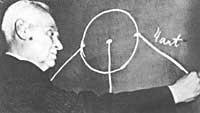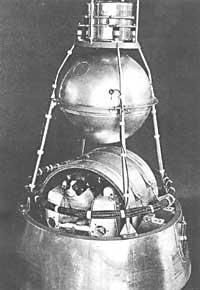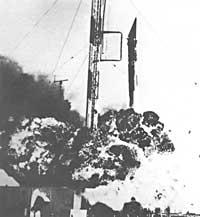4 October 1957, day of breaking chains
1987/12/01 Barandiaran, Mariaje | Irazabalbeitia, Inaki - kimikaria eta zientzia-dibulgatzaileaElhuyar Fundazioa Iturria: Elhuyar aldizkaria

To say that Sputnik 1 broke the chains may be a little more, but that marked the beginning of a new era in the history of humanity. The chains of imagination were broken between writers and readers for a long time, and the most skeptical ones channeled the first human instrument that the Soviet Union placed in space that day into the cemetery of spatial mentality.
Sputnik 1 was not much, it barely weighed 84 kg, but its influence has been enormous. Few could imagine that at a few years, four October thirty years ago (and after overcoming the first surprise of the novelty), the orbit of a satellite would not surprise anyone. Currently the probes placed in space by man are about to exceed the limit of our planetary system on a long journey to the remote stars. During this time, our bottles have broken the millenary peace of the moon; the automatic probes sent by us have settled on the nearest planets (Artizar and Martitz); the probes sent in search of gigantic outer planets have provided us with a new vision of the structure and state of our system; and, perhaps more importantly, the information supplied by the satellites and transmitted indispensable through the satellites has become indispensable.
The world of space is an ordinary day, day by day. But in 1957 it was totally different. The launch of Sputnika had a great influence all over the world and especially in the US. What was the atmosphere he lived in those days?
Reactions to the Sputnika launch were divided into two groups, as the world was politically divided into two blocks. The first reaction of the Westerners was a surprise. Everyone expected the first satellite to put the US in space. The second reaction was criticism (to the US) for not having made the necessary efforts at the time of preparing a suitable projector).

It was a big blow to US society. After winning World War II and laying the foundations of atomic energy, they were left behind in the space race. American pride was greatly affected. It was known, and also wonderful, that the Soviets were going to put a satellite into orbit, but the Americans did not heed the predictions, but regarded them as Soviet propaganda. According to the Americans, the first human instrument to be put in space was launched from Cape Cañaberal.
Pride was the response of some Americans. Admiral Bennet, leader of the Maritime Operations, said the satellite was a piece of iron that anyone could throw. But the words then written by British journalist Patrick Donovan seem to better summarize the opinion of the American population: The idea that a totalitarian people, making an effort in a major research project, can overcome a rich democratic people, is considered impossible.
However, the North American launches of Sputnika, for prestigious reasons, initially embarked on a space contest, although they did not want to accept that there was competition.
Moreover, the trauma of the Sputnika launch intensified with the orbit of the second Sputnika on November 3 of the same year. This was fifteen times heavier than the other and carried the dog Laika inside. American pride was offended even more. The Soviets had two satellites in orbit and the Americans remained on the ground unable to overcome some mechanical problems. The Americans had to wait until January 31, 1958 to place their Explorer Ia in space. A sample of the atmosphere that lived at that time is what physicist Edward Teller said when asked what he expected to find on the Moon: Russians.

In the other block and as expected, this success on the road to space opened the doors to propaganda. Proof of this is the writing of the agency Tass when announcing the new: This present generation seems to witness what the free and conscious work of the popular of the new socialist society has made the most daring dream of the human being a reality.
The mentality of the space has taken many turns since then, although on October 4, 1957 it is in the canton of the street. The launch of Sputnika caused that, still unfinished completely, this interesting and attractive menture that was born thirty years ago focuses on new horizons.

Gai honi buruzko eduki gehiago
Elhuyarrek garatutako teknologia



